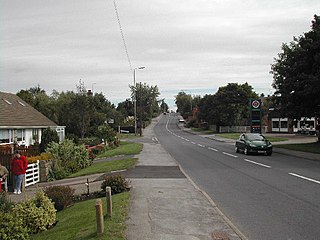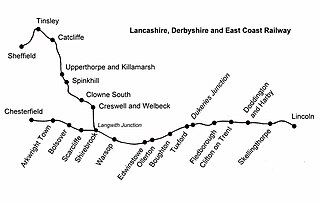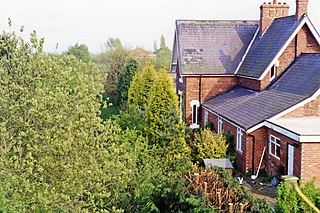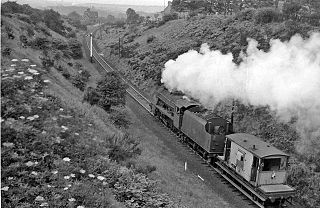
Sherwood is a constituency represented in the House of Commons of the UK Parliament since 2010 by Mark Spencer, a Conservative. The constituency's name is common with Sherwood Forest which is in the area.

Bilsthorpe is a village and civil parish in the Newark and Sherwood district of Nottinghamshire, England. According to the 2001 census it had a population of 3,076, increasing to 3,375 at the 2011 census, and dropping slightly to 3,365 at the 2021 census. It is located near the junction of the A614 and A617, around 5 miles south of Ollerton, 9 miles east of Mansfield and 6 miles north-west of Southwell.
The Erewash Valley Line is a railway line in England, running from Long Eaton, located between Nottingham and Derby, and Clay Cross, near Chesterfield. The southern part was opened by the Midland Railway in 1847 as far as Codnor Park, where it connected to established ironworks, and soon after, a line to Pinxton and Mansfield.

Rolleston station is a stop on the Nottingham to Lincoln Line. It is located around half a mile from the small village of Rolleston, one of the Trent-side villages near Southwell in Nottinghamshire, England. The station adjoins Southwell Racecourse.

Shirebrook railway station serves the town of Shirebrook in Derbyshire, England. The station is on the Robin Hood Line, 21½ miles (35 km) north of Nottingham towards Worksop.

Mansfield railway station serves the town of Mansfield in Nottinghamshire, England. It was also known as Mansfield Town, to distinguish itself from the GCR's former Mansfield Central and Mansfield Woodhouse stations. It is a stop on the Robin Hood Line, located 17 miles (27 km) north of Nottingham; it is managed by East Midlands Railway. The station building is Grade II listed.

Rainworth is a village in the ceremonial county of Nottinghamshire in the East Midlands of England. It is split between the local government districts of Newark and Sherwood and Mansfield. To the north of Rainworth is the village of Clipstone and to the east are the villages of Bilsthorpe and Farnsfield. Mansfield lies two miles to the west and the village of Blidworth is a mile to the south.

The A617 road runs through the northern East Midlands, England, between Newark-on-Trent and Chesterfield.
The Lancashire, Derbyshire and East Coast Railway (LD&ECR) was built to connect coalfields in Derbyshire and Nottinghamshire with Warrington and a new port on the Lincolnshire coast. It was a huge undertaking, and the company was unable to raise the money to build its line. With the financial help of the Great Eastern Railway it managed to open between Chesterfield and Lincoln with a branch towards Sheffield from 1896. Despite efforts to promote tourist travel, the passenger business was never buoyant, but collieries were connected to the line, at first and in succeeding years. The Great Eastern Railway, and other main line companies, transported coal to the southern counties, and the company's engines took coal to Immingham in great quantities. The company had a fleet of tank engines.

Ollerton railway station is a former railway station in Ollerton, Nottinghamshire, England.

The Mansfield Railway was an eleven-mile railway line in Nottinghamshire, England. It was built to serve collieries opening in the coalfield around Mansfield, and ran between junctions at Clipstone and Kirkby-in-Ashfield on the Great Central Railway. It opened in 1916 and was worked by the GCR. Passenger stations were opened on the line, although, at the date of opening, road bus competition was already dominant.

Pleasley West was a railway station on the Doe Lea line in Pleasley, Derbyshire, England on the border of Derbyshire and Nottinghamshire. It opened in 1886 and closed to scheduled services in 1930, though it was served by excursion trains until 1964.
The Doe Lea branch is a mothballed railway line in Derbyshire, England. It connected the Derbyshire towns of Chesterfield, Staveley and Bolsover to the Nottinghamshire town of Mansfield. It also had a branch line to Creswell via the Derbyshire town of Clowne.

Southwell railway station served the town of Southwell in Nottinghamshire, England, from 1847 to 1959. It was a stop on the Rolleston Junction-Mansfield line.

Kirklington and Edingley railway station was a railway station serving the villages of Edingley and Kirklington in Nottinghamshire, England. It was on the Midland Railway's Rolleston Junction to Mansfield line.

Farnsfield railway station was a railway station serving the village of Farnsfield, Nottinghamshire, England. It was on the Midland Railway's Rolleston Junction to Mansfield line.

Blidworth and Rainworth railway station served the villages of Blidworth and Rainworth in Nottinghamshire, England; it was a stop on the Midland Railway's Rolleston Junction to Mansfield line.
Bilsthorpe Moor is a hamlet in the civil parish of Bilsthorpe, in the Newark and Sherwood district of Nottinghamshire, England. It is 120 miles north of London, 13 miles north east of the city of Nottingham, and 5 miles south of Ollerton, and close to the junction of the A614 and A617 roads.

The Southwell Trail is a 7.5-mile (12.1 km) long multi-user trail, for use on foot, cycle and horseback, that links Bilsthorpe and Southwell in the English county of Nottinghamshire. It uses parts of the track bed of two former railway lines. It has been designated as a Local Nature Reserve.














